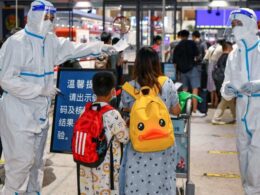Executive Summary by:
Joaquim Cardoso MSc.
Health Transformation — Journal
September 20, 2022
Prioritized Recommendations from the Four Consensus Studies
The authors hope that the prioritized areas of focus outlined previously in this paper will be helpful to decision makers as they allocate resources to begin shoring up pandemic preparedness but understand that even more specific actions may be beneficial in making resource allocation decisions.
To that end, the authors have highlighted three specific recommendations from the consensus studies that can begin improving future pandemic preparedness immediately.
Failure to address these priorities for action could result in catastrophic failure when the next pandemic arises, and we must not miss the opportunity to act.
The three recommendations identified by the authors for immediate action are expanded upon below.
- 1.Increased Investments in Surveillance Systems for Pathogens with Pandemic Potential
- 2.Creation of a Global Pandemic Manufacturing and Supply Chain Task Force
- 3.Ensuring Appropriate Access to Medical Products and Countermeasures
Failure to address these priorities for action could result in catastrophic failure when the next pandemic arises, and we must not miss the opportunity to act.
Selected images:
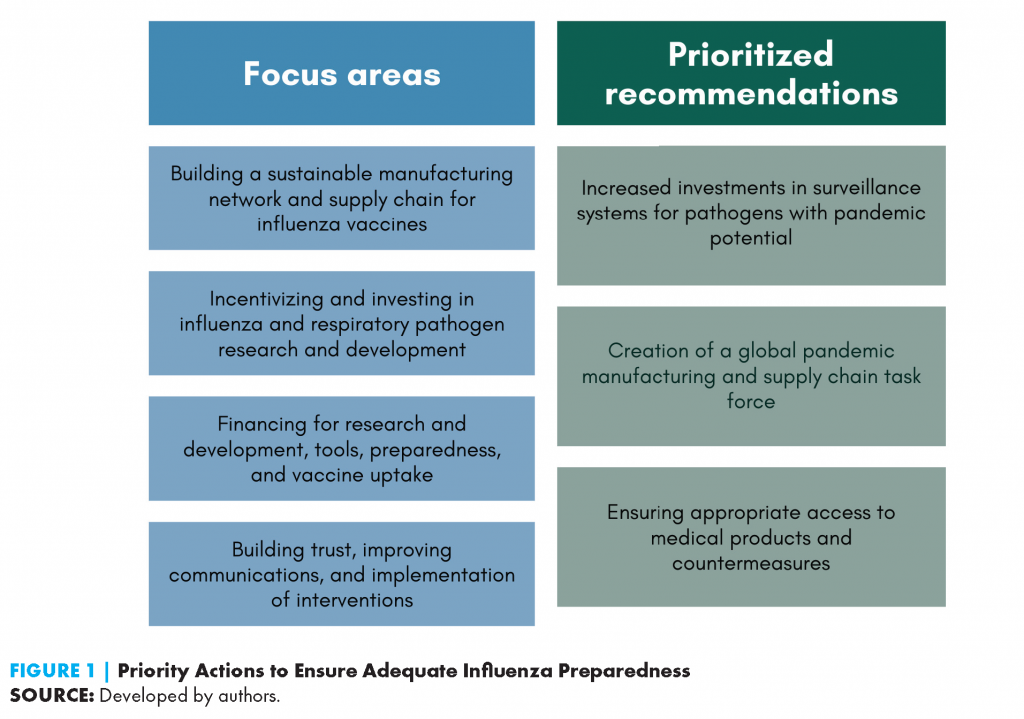


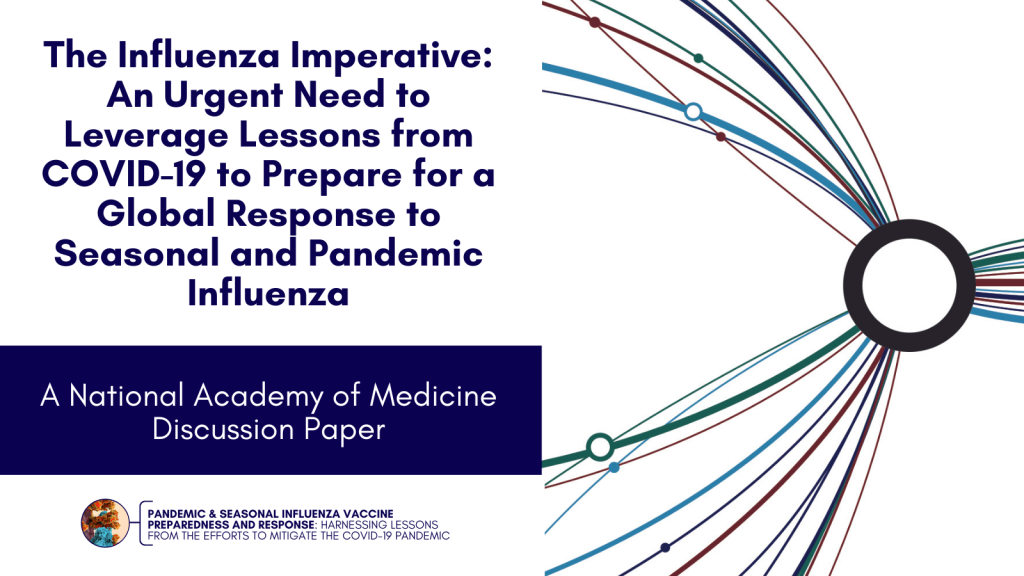
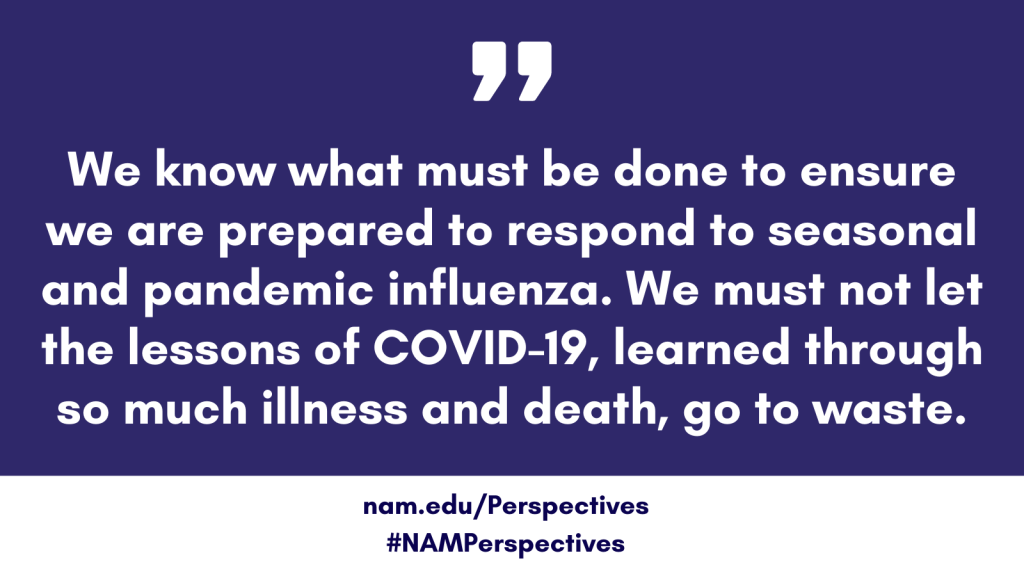
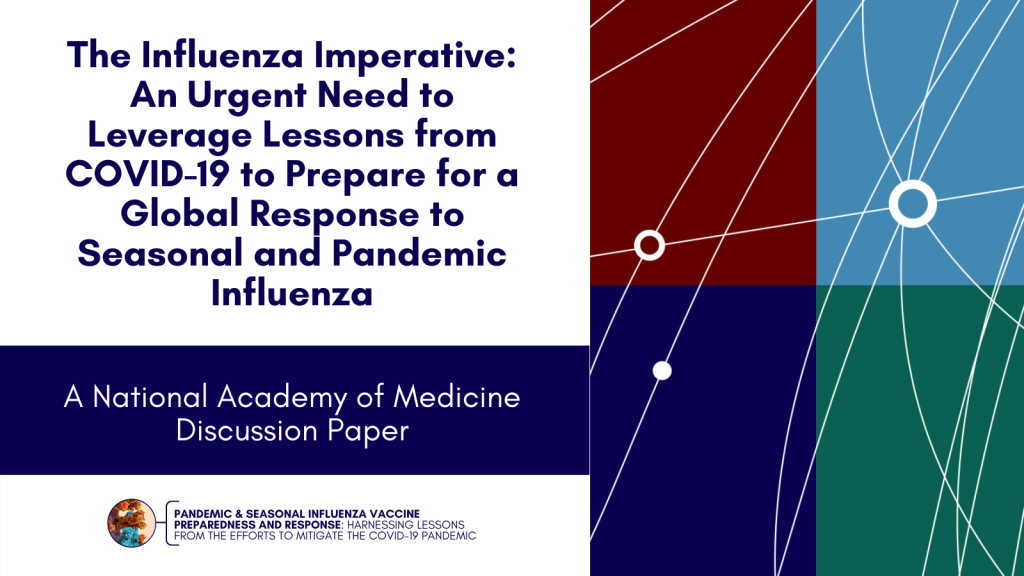
ORIGINAL PUBLICATION
The Influenza Imperative: An Urgent Need to Leverage Lessons from COVID-19 to Prepare for a Global Response to Seasonal and Pandemic Influenza
National Academy of Medicine
By W. Ripley Ballou, Norman Baylor, Thomas Cueni, Victor Dzau, Keiji Fukuda, Patricia Jannet Garcia, Anuradha Gupta, Etleva Kadillli, Lawrence Kerr, Heidi J. Larson, John Simpson, Kanta Subbarao, and Prashant Yadav
September 19, 2022 | Discussion Paper

Since December 2019, much of the world’s focus has been on coronavirus disease 2019 (COVID-19) as it emerged from Wuhan, China and rapidly spread across the world.
As of this writing, there were over 570 million confirmed cases of COVID-19 globally, and more than 6 million people have lost their lives to the disease (WHO, n.d.). Infectious disease detection, treatment, prevention, and control are at the forefront of many people’s minds in 2022. However, concern over the continuing pandemic response and future preparedness has historically waned between pandemics and other major infectious disease outbreaks, resulting in inconsistent and inadequate efforts needed to ensure sufficient levels of pandemic preparedness (Johnson, 2014). The world cannot repeat this historical pattern-we must use the lessons learned from this pandemic to propel and sustain preparedness efforts moving forward, with an emphasis on addressing some of the most glaring gaps that inhibited the COVID-19 response.
COVID-19 has demonstrated the catastrophic consequences of a pandemic. It has also shown the world that our current systems, processes, and organizations were not prepared for a respiratory pandemic.
The significant and incredible advances made during this pandemic happened despite an infrastructure that was ill-prepared for COVID-19. A better-prepared world might have avoided much of the death, disruption, and disorganization caused by COVID-19 and made even greater advances in vaccine research and development, supply chain infrastructure, public health interventions, and global coordination. However, the response to COVID-19 has propelled the world’s preparedness infrastructure forward significantly-the time is now to ensure that this infrastructure is maintained, supported, and provided the necessary resources to grow so that it can respond nimbly when the next virus with pandemic potential emerges. The authors also fully acknowledge that much more can and should be done to advance preparedness, and the forward motion experienced since 2020, while exciting, is not sufficient.
The authors of this manuscript believe, as many infectious disease professionals do, that future pandemics are not an “if” but a “when” (Kelland, 2019).
More specifically, the authors believe that some or many of these future pandemics will be caused by an influenza virus (Gavi, 2021). Despite the world’s recent experience with coronaviruses, virologists continue to monitor influenza viruses closely because of their history of causing severe pandemics, their genetic ability to develop “novel” viruses with the capability to initiate a pandemic, and because changes in global and regional environmental and societal conditions involving contact between humans and animals appear favorable for the emergence and spread of such influenza viruses (NASEM and NAM, 2022d). Because individuals worldwide are familiar with seasonal influenza and yearly influenza vaccination programs, there may be a perception that influenza is not as exotic or dangerous as COVID-19. However, the possibility of a severe influenza pandemic is very real and very frightening. The 1918 influenza pandemic killed an estimated 50 million people worldwide, and other influenza pandemics throughout history have caused both human and economic devastation (CDC, 2019a). The economic burden of a moderate-to-severe influenza pandemic is estimated to cost the global economy trillions of dollars (CIDRAP, 2008).
An estimated one billion people worldwide are infected by seasonal influenza every year (WHO, 2019).
Of these one billion cases, three to five million result in severe illness, and as many as 650,000 people die every year from influenza (WHO, 2019). In addition to the human toll, seasonal influenza also causes billions of dollars of economic loss and strains to health care systems annually (O’Brien, 2017). Seasonal human influenza viruses are highly contagious, mutate frequently, and are well-adapted to infecting people, which allows them to mount serious annual outbreaks in many parts of the world (WHO, 2019). However, animal influenza viruses or hybrid animal-human influenza viruses that do not usually infect people are considered to pose an even greater pandemic threat (CDC, 2019b). When such a virus gains the ability to infect and spread among people, as happens from time to time, a pandemic is possible. The protective measures put in place to protect against the spread of COVID-19 have also reduced seasonal influenza transmission and infection since 2020, leaving portions of the global population likely immunologically naïve to circulating viruses and a spike in infections and mortality a real possibility (CDC, 2021).
An estimated one billion people worldwide are infected by seasonal influenza every year (WHO, 2019).
In the face of the twin threat of seasonal and pandemic influenza, influenza vaccination is the optimal preventive strategy compared to other non-pharmaceutical interventions.
Increased rates of influenza vaccine acceptance could also lead to increased herd immunity among populations and decrease viral spread, which could reduce the morbidity and mortality of seasonal and pandemic influenza. However, influenza vaccination consistently faces complacency and is often low on the health agendas and annual budgets of many countries across the globe. History, science, and the ongoing COVID-19 experience tell us that the world must be better prepared to produce vaccines quickly, ensure that the distribution and administration of available supplies are equitable and fair, and that the public is aware and willing to cooperate — a challenge faced in some settings in the global COVID-19 vaccination rollout.

Advancing Pandemic and Seasonal Influenza Vaccine Preparedness and Response Initiative
This threat is urgent and real, and is the reason the National Academy of Medicine (NAM) launched the Advancing Pandemic and Seasonal Influenza Vaccine Preparedness and Response Initiative (the Initiative) (NAM, n.d.). rapidly identify the lessons learned from COVID-19 and capitalize on innovations in vaccine research, development, manufacturing, equitable distribution, allocation, and administration, the U.S. Health and Human Services Office of Global Affairs asked the NAM to establish an International Committee to inform and facilitate the Initiative. Members of the International Committee have long-standing global experience in vaccine development, public health, preparedness, health policy, and government (NAM, n.d.). The authors of this manuscript are all members of the International Committee.
The International Committee convened to identify existing gaps in pandemic influenza practice and discuss key capabilities, technologies, processes, and policies learned from COVID-19 and previous experiences that could strengthen future preparedness, especially related to vaccines.
To gain additional knowledge and perspectives, the International Committee convened a three-day international workshop to discuss these issues and related topics (NAM, 2021). The deliberations of the International Committee and the discussions at the international workshop all informed the development of four separate but related consensus study reports. Some members of the International Committee served as members of the four consensus studies, but not all. The International Committee as a body did not influence the consensus study committees beyond establishing the initial scope of their work. This manuscript is written by members of the International Committee as individuals and should not be viewed as formal statements of any of the consensus study committees.
The authors recognize that the efforts of the International Committee, the consensus study committees, and the NAM are certainly not the only initiatives trying to glean and operationalize lessons learned from COVID-19.
The authors wish to acknowledge the work of The Independent Panel for Pandemic Preparedness and Response and their report COVID-19: Make It the Last Pandemic; the G20 High Level Independent Panel on Financing the Global Commons for Pandemic Preparedness and Response (Dr. Victor Dzau served as an advisor to the Panel) and their report A Global Deal for Our Pandemic Age; the Pandemic Preparedness Partnership and their report 100 Days Mission to Respond to Future Pandemics; and the Pan-European Commission on Health and Sustainable Development (FGCPPR, 2022; The Independent Panel, 2022; WHO, 2022; G20 High Level Independent Panel, 2021; gov.uk, 2021; Pandemic Preparedness Partnership, 2021; The Independent Panel, 2021).
This paper focuses on the NAM’s initiative and subsequent consensus studies because this is the area of expertise of the authors and due to the comparatively broad and deep scope of the four consensus studies.
The authors believe that, together, the four consensus studies provide a solid foundation for action toward improving global disease preparedness. However, the authors also believe that the topics covered in this paper are not sufficient to adequately prepare for seasonal or pandemic influenza, or the potential emergence of another pathogen with pandemic potential, and that there is much to be learned from the efforts detailed above and others the authors have not listed here.
The authors firmly assert that openly sharing knowledge, best practices, failures, successes, and support is the world’s best chance to adequately prepare for seasonal and pandemic influenza and other emergent diseases.
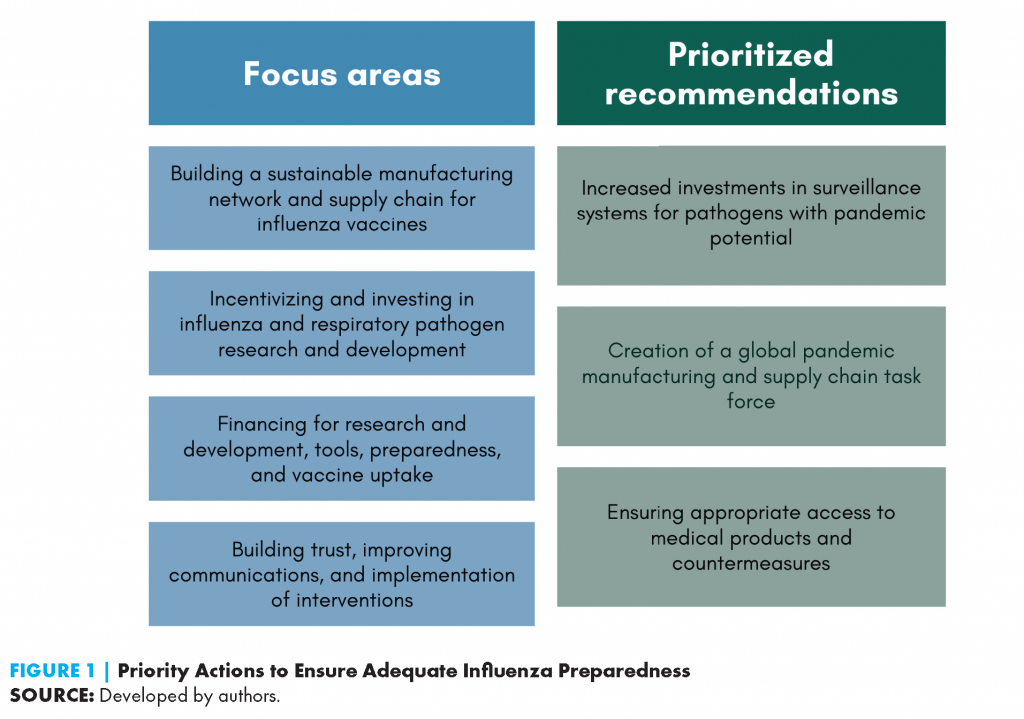
Manuscript Outline and Approach
This discussion paper aims to synthesize work conducted by the Initiative, which produced four National Academies of Sciences, Engineering, and Medicine (NASEM)-run consensus studies, focused on global coordination on vaccines; globally resilient vaccine supply chains; non-vaccine public health interventions; and vaccine research and development (NAM, n.d.; NASEM and NAM, 2022a; NASEM and NAM, 2022b; NASEM and NAM, 2022c; NASEM and NAM, 2022d).
This paper endeavors to present a short, actionable list of potential areas of focus for immediate and concerted effort by decision makers, including national and international governments and governmental agencies, nongovernmental organizations, funders, pharmaceutical manufacturers, public health officials, and all others interested in ensuring a robust and efficient disease preparedness infrastructure.
This discussion paper highlights the recommendations presented in the consensus studies, which fall into four focus areas prioritized for immediate action:
- Building a sustainable manufacturing network and supply chain for influenza vaccines
- Incentivizing and investing in influenza and respiratory pathogen research and development
- Financing for research and development, tools, preparedness, and vaccine uptake
- Building trust, improving communications, and implementation of interventions
After discussing the critical aspects of these four focus areas, the authors identified specific recommendations from the consensus studies that fall within these focus areas and that they believe must be implemented soon to avoid catastrophic failure in the next pandemic response:
- Increased investments in surveillance systems for pathogens with pandemic potential
- Creation of a global pandemic manufacturing and supply chain task force
- Ensuring appropriate access to medical products and countermeasures
While these prioritized areas of focus and recommendations have the potential to reduce major gaps in future pandemic preparedness and response, especially as related to vaccines, they do not cover all areas of need.
The authors of this manuscript reiterate that there are many lessons to be learned from COVID-19, and a comprehensive understanding of and renewed approach to pandemic preparedness will be vital to ensuring we are ready when the next pathogen, be it influenza or otherwise, emerges.
The four consensus study reports, detailed below, also cover additional aspects of pandemic preparedness that are not covered in this paper and may be of interest to readers.
The authors of this manuscript reiterate that there are many lessons to be learned from COVID-19, and a comprehensive understanding of and renewed approach to pandemic preparedness will be vital to ensuring we are ready when the next pathogen, be it influenza or otherwise, emerges.

Consensus Study Reports
The consensus study reports that the four study committees produced are briefly outlined below.
The reports themselves contain significantly more detail and depth for readers who might be interested in the full suites of recommendations.
Countering the Pandemic Threat Through Global Coordination on Vaccines identifies ways to strengthen pandemic and seasonal influenza coordination, partnerships, and financing (NASEM and NAM, 2022d).
The committee’s deliberations were based on a single premise: starting with the first human detection of a novel influenza virus with pandemic potential, how can the global health community move as quickly as possible to develop and produce safe and effective vaccines and equitably immunize as many people as possible worldwide?” (NASEM and NAM, 2022d).
The committee’s recommendations include:
- using principles adopted in earlier global framework negotiations,
- developing integrated preparedness and response agendas,
- establishing increased and enduring financing, and
- working on a universal influenza vaccine, among others.
Globally Resilient Supply Chains for Seasonal and Pandemic Influenza Vaccines outlines approaches to bolster vaccine distribution, manufacturing, and supply chains for future seasonal and pandemic influenza events (NASEM and NAM, 2022b).
The committee considered all aspects of vaccine manufacturing and distribution from both a U.S. and global perspective.
Their recommendations include:
- creating, staffing, and funding a global task force focused on manufacturing and supply chain issues;
- developing strategies to improve the vaccine manufacturing workforce;
- evaluating a means of fostering and scaling up global vaccine manufacturing capacity;
- commissioning studies in demand forecasting and uptake;
- developing forecasting and supply and demand tools; and
- ensuring quick scale-up of production when necessary.
Public Health Lessons for Non-Vaccine Influenza Interventions examines how to leverage the knowledge gained from the COVID-19 pandemic to optimize the use of public health interventions other than vaccines to decrease the toll of influenza (NASEM and NAM, 2022c).
The report considered the effectiveness of public health efforts such as the use of masks and indoor spacing, therapeutics treatments, and public health communication campaigns.
The committee’s recommendations include:
- improving routine surveillance in animals and for novel viruses and strains;
- providing specific guidance on mask wearing, ventilation, and use of plexiglass barriers;
- incentivizing more integration of research among scientific and medical fields to inform investigations of transmission, prevention, and treatment of pathogens;
- developing and strengthening national pandemic preparedness plans;
- improving evidence-based communication strategies with the public before and during emergency events; and
- ensuring equity throughout public health interventions.
Vaccine Research and Development to Advance Pandemic and Seasonal Influenza Preparedness and Response focuses on how to leverage the knowledge gained from the COVID-19 pandemic to optimize vaccine research and Development to support the prevention and control of pandemic influenza, specifically focused on the promising areas of basic and translational science, clinical science, manufacturing science, and regulatory science (NASEM and NAM,
2022a).
The committee’s recommendations include:
- investing in a diverse array of potential influenza vaccines, including different platforms, viral targets, adjuvants, and delivery systems;
- conducting burden of disease studies in low- and middle-income countries (LMICs) to make a case for seasonal influenza vaccines;
- developing systems for transparent and continuous review of global vaccine safety data;
- encouraging benchmarking, prioritization, and harmonization, where possible, of vaccine manufacturing; and
- producing comprehensive guidance on developing influenza vaccines on novel platform release, authorization, and distribution.

Consensus Study Recommendation Areas of Focus
The four consensus study committees produced 96 recommendations and sub-recommendations-all of which, if implemented, can move the global preparedness environment toward more universal and nimble readiness.
The authors of this manuscript have grouped the 96 recommendations into four overarching areas of focus that the authors hope will assist global decision makers in digesting the consensus studies and moving quickly to action.
The four consensus study committees produced 96 recommendations and sub-recommendations-all of which, if implemented, can move the global preparedness environment toward more universal and nimble readiness.
The four areas of focus include:
- 1.Building a sustainable manufacturing network and supply chain for influenza vaccines
- 2.Incentivizing and investing in influenza and respiratory pathogen research and development
- 3.Financing for research and development, tools, preparedness, and vaccine uptake
- 4.Building trust, improving communications, and implementing interventions

1.Building a Sustainable Manufacturing Network and Supply Chain for Influenza Vaccines
COVID-19 simultaneously highlighted the robust and flexible nature of global supply chains and manufacturing networks, but also how ill-prepared they were to manage manufacturing vaccines and related products at a level to sustain a protracted pandemic response.
While comparatively high levels of vaccination against COVID-19 were achieved in high-income countries in less than a year from the first emergency use authorization of COVID-19 vaccines, in March 2022, approximately two years after the announcement of COVID-19 as a Public Health Emergency of International Concern, LMICs worldwide continue to struggle to obtain and deliver enough vaccines to immunize their populations (WHO, 2020). This struggle is due to inequities of global distribution-exacerbated by poor quality of supply and demand data, supply chain shortages of critical manufacturing components, logistical distribution hurdles for vaccines with complicated administration requirements, and the concentration of manufacturing capacity in mostly high-income countries. For example, Africa produces only one percent of the vaccines it consumes domestically, making the continent entirely reliant on importing vaccines from other countries (DFC, n.d.). Finally, many countries with a surplus, as seen during COVID-19, hoarded vaccines, further worsening vaccine distribution and access challenges (Nebehay and Mason, 2021).
Expanding the geographic distribution of vaccine production centers, combined with a well-functioning and well-coordinated global supply chain and manufacturing network, and adequately financing them to perform at the outset of a pandemic will be critical in responding to an influenza pandemic, especially if the demand for vaccines is high.
This geographic distribution of production centers must also be coupled with incentives for and strategies to achieve global vaccine equity, in which high-income countries and LMICs have the same access to life-saving vaccines. Additionally, focused investment in a sustainable manufacturing network and robust supply chain will likely benefi t and support the production of all vaccines, not only those for influenza, providing additional preparedness for other potentially pandemic diseases.
Establishing new manufacturing centers can provide a foundation for interpandemic vaccine manufacturing and a source for many other necessary products during an influenza pandemic, including therapeutics and ancillary items such as syringes, needles, and vials to support vaccine delivery, if development of the architecture is coordinated across the vaccine, therapeutic, and diagnostic supply chains.
As has become evident during COVID-19, managing the complexities of an end-to-end vaccine manufacturing supply network during a pandemic and in the interpandemic period requires a global entity, like, perhaps, the WHO, “to coordinate the actions of multiple stakeholders and ensure production and distribution of numerous inputs, equipment, resources, and infrastructure” (NASEM and NAM, 2022b).
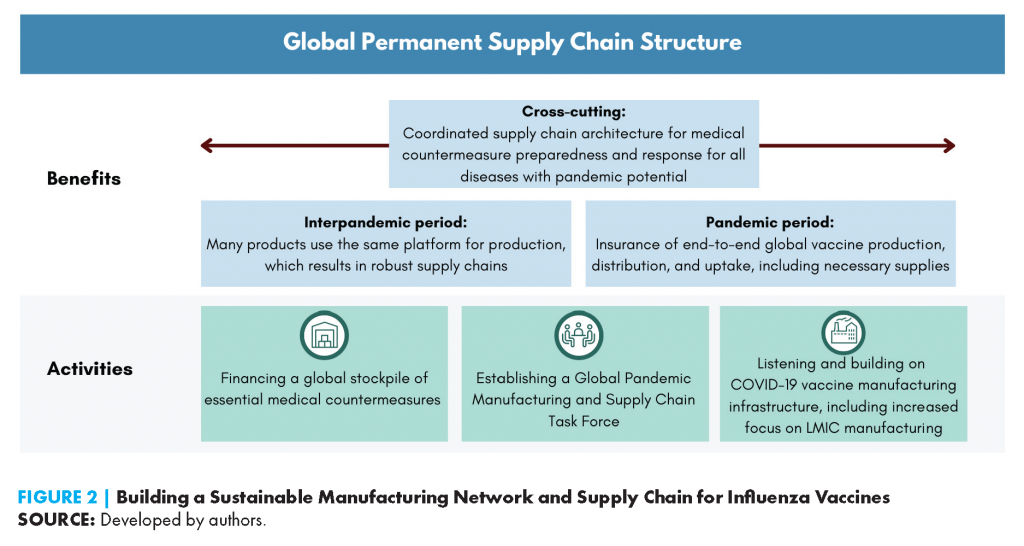
2.Incentivizing and Investing in Influenza and Respiratory Pathogen Research and Development
Given the high likelihood that a major pandemic will arise from a strain of pandemic influenza, investments in quickly deployable measures to enable a more effective response to reduce the health consequences and disruption from influenza would seem like an obvious priority.
However, research on these pathogens and innovations to mitigate their dangers have not been prioritized in recent years, and as history has taught repeatedly, the heightened concern and attention during an outbreak often recedes quickly as the outbreak wanes. The need for additional research and development into improved tools and techniques to combat seasonal and pandemic influenza is clear (NASEM and NAM, 2022a). The knowledge gained from more sustained and dedicated research and development into better understanding respiratory pathogens and how best to respond to their emergence and mutation could position the world to mount a better rapid response to the next pandemic in facilitating the development of more effective vaccines and therapeutics and employing more effective non-pharmaceutical interventions, both of which could directly target the specific characteristics of an emergent virus-a response that we were not prepared to execute for COVID-19.
It is critical to capitalize on dedicated research and development now because there are so many lessons learned from the extremely rapid development of effective and safe COVID-19 vaccines.
Documenting and adopting best practices and effective approaches before the next pandemic emerges is possible. The global pandemic catalyzed new relationships, like those between competitors in the pharmaceutical industry and very large and very small companies, as seen with the Pfizer/BioNTech vaccine. These partnerships have allowed for unique and necessary insights and breakthroughs that must be better understood and interrogated.
While investment in respiratory pathogen vaccine research and development and the subsequent findings and insights may directly benefit pandemic preparedness, they may also benefit efforts to address infectious diseases more broadly.
“Burden-of-disease studies in low- and middle-income countries could help ensure development of infrastructure and capacity needed for pandemic vaccine development and implementation” (NASEM and NAM, 2022a). Global data infrastructure and capacity building for site surveillance of vaccine safety and effectiveness across diverse populations will also ensure stronger response in a future pandemic scenario. Insights from research and development of influenza vaccines and therapeutics can help guide future public health interventions, support the use of new technologies for emerging viruses, and direct research and development for future interventions. Such foundations will help to be better prepared for a potential future pandemic, as well as other infectious disease outbreaks.
Any research into pathogens with pandemic potential will necessarily be impacted by current policies and protocols around funding and approval for studies involving Potential Pandemic Pathogen Care and Oversight (P3CO).
These issues have become more prominent since the publication of the consensus study and as such, was not discussed by the committee or included in their recommendations, but will impact the implementation of the recommendations from the committee.
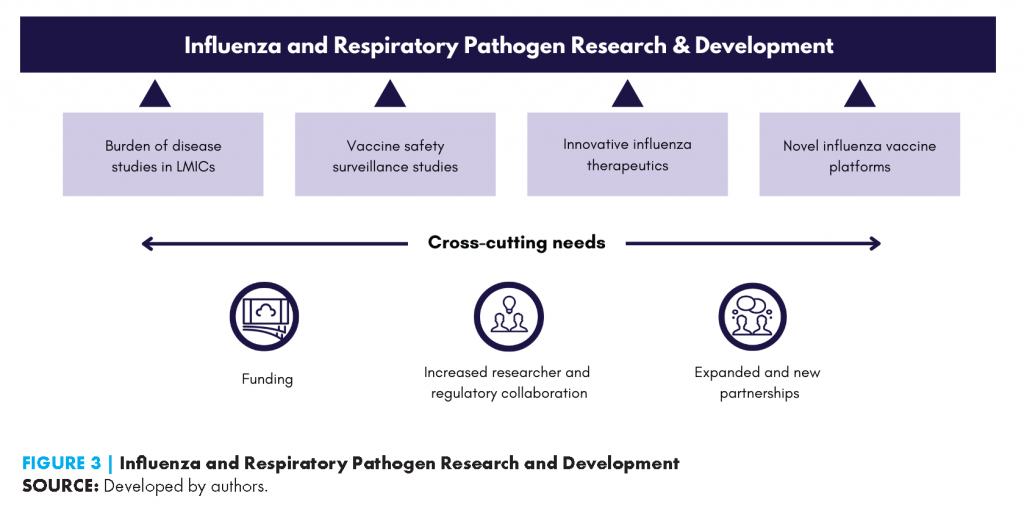
3.Financing for Research and Development, Tools, Preparedness, and Vaccine Uptake
None of the approaches, areas of focus, or necessary actions outlined in this manuscript will be possible without adequate and sustained financing, as well as effective governance to ensure that financing is allocated, spent, and tracked responsibly.
Financing is not the only variable in implementing the priority actions needed, but it is a crucial indicator of commitment and support. The need for sustained funding has been discussed at length throughout COVID-19 and the decades prior. Research and development cannot be conducted without adequate and sustained financing. It is impossible to strengthen capacity in manufacturing and supply chain operations without financing. Strengthening the infrastructure needed to prepare and roll out public health interventions at any scale is also impossible without financing.
None of the approaches, areas of focus, or necessary actions outlined in this manuscript will be possible without adequate and sustained financing, as well as effective governance to ensure that financing is allocated, spent, and tracked responsibly.
Global sustainable financing for preparedness, response, and recovery will necessarily need to include and consider the needs of high, medium, and low resource settings and geographic areas.
Every nation has a role to play in ensuring adequate financing, whether that is directly contributing funding; convincing other nations to participate; contributing to trials, sample collection, stockpiling, and production of necessary resources; training necessary workforce; contributing to surveillance and sharing data with other nations; or communicating clearly and truthfully about public health interventions and the state of a future pandemic.
A notable development during the drafting of this paper was the World Bank’s approval of a Financial Intermediary Fund (FiF) to support and strengthen pandemic prevention, preparedness, and response.
At the time of this paper’s writing, over $1 billion was pledged to the fund from a variety of countries and two private philanthropies.
This type of large-scale, globally-focused financing will be critical to ensuring coordinated and comprehensive pandemic preparedness, but even more investment is needed to ensure a level of preparedness necessary to combat the next global pandemic. This fund and others must be prioritized by additional countries and governments worldwide, as global collaboration is needed to ensure an effective global response.

4.Building Trust, Improving Communications, and Implementation of Interventions
Perhaps one of the fundamental lessons of the COVID-19 pandemic is the need for clear, consistent, and trusted communication, especially when misinformation is so readily spread.
The past two years have seen successes in countries and communities where the public trusted the leaders who were conveying critical information to them and saw concrete actions to protect citizens from the pandemic, including making testing, therapeutics, and eventually vaccinations free, easy to access, and widely available (Thornton, 2022). We have also seen the harmful impact of distrust in authorities in low vaccine acceptance and sporadic compliance with other COVID-19 control measures among marginalized and politically polarized groups (Hamel et al., 2021).
Perhaps one of the fundamental lessons of the COVID-19 pandemic is the need for clear, consistent, and trusted communication, especially when misinformation is so readily spread.
Preparations to successfully mitigate the negative impacts of the next pandemic will include ensuring a robust supply chain; investing in vaccine research and development; and maintaining and reinforcing innovative, global, and cross-sectoral relationships.
However, all of these advances will be irrelevant if individuals refuse or defer vaccines or ignore public health safety precautions and recommendations. Building, and in some instances, rebuilding, trust between the public, authorities managing pandemic responses, and scientific and medical leaders nationally and globally is necessary to ensure an effective coordinated response to the next pandemic. Building this trust will require better, clearer, and more coordinated communications between policymakers, health care professionals, media, local leaders, and communities. Such communications must also reinforce the reality that optimally responding to public health crises requires a partnership among all affected parties. Understanding how to better meet the communication needs of local communities and sub-populations requires research that needs investment well before, as well as during, the next pandemic to ensure that communication is effective and adapts to meet evolving needs. Establishing additional meaningful and enduring relationships between governments and trusted messengers in communities-faith leaders, local politicians, health care workers, elders, and other individuals that communities trust-will also be key. Communication about emerging science, public health interventions, or other requested actions need to be conveyed in ways that are appropriate, understandable, and sensitive to communities. Additional research into effective mechanisms for these evidence-based communications, including a deeper understanding of how misinformation and disinformation spreads via social media, as well as a focus on knowledge gained from the social sciences, is needed prior to the emergence of the next pandemic. Trust can only be built over time and cannot be rushed. It needs financial and human resources and investment before crises erupt, as it is the most foundational governance requirement for a nimble and effective response to the next pandemic, yet is often under-funded.

Prioritized Recommendations from the Four Consensus Studies
The authors hope that the prioritized areas of focus outlined previously in this paper will be helpful to decision makers as they allocate resources to begin shoring up pandemic preparedness but understand that even more specific actions may be beneficial in making resource allocation decisions.
To that end, the authors have highlighted three specific recommendations from the consensus studies that can begin improving future pandemic preparedness immediately.
Failure to address these priorities for action could result in catastrophic failure when the next pandemic arises, and we must not miss the opportunity to act.
The three recommendations identified by the authors for immediate action are expanded upon below.
- 1.Increased Investments in Surveillance Systems for Pathogens with Pandemic Potential
- 2.Creation of a Global Pandemic Manufacturing and Supply Chain Task Force
- 3.Ensuring Appropriate Access to Medical Products and Countermeasures
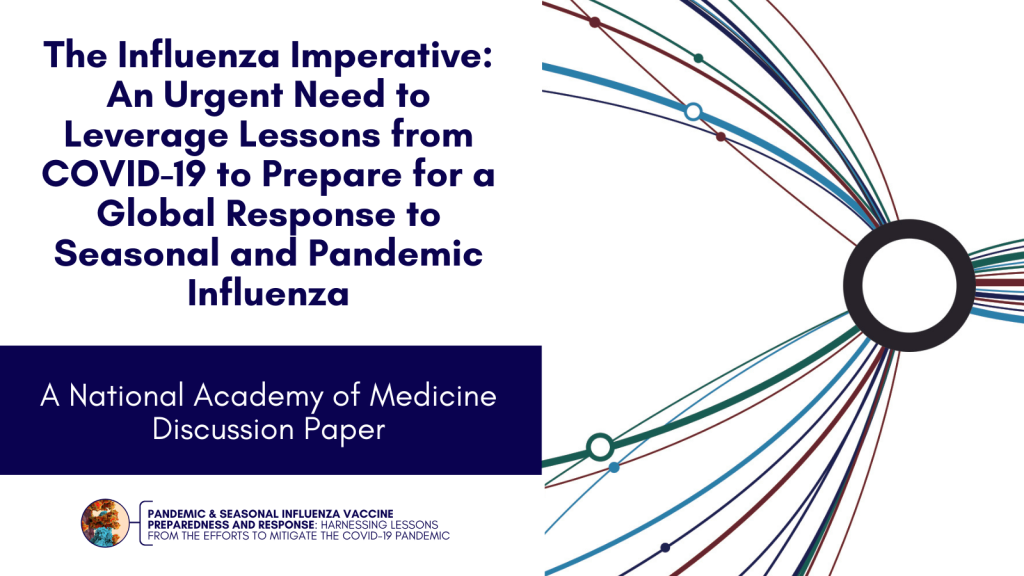
1.Increased Investments in Surveillance Systems for Pathogens with Pandemic Potential
Recommendation 2 from Countering the Pandemic Threat through Global Coordination on Vaccines reads (NASEM and NAM, 2022d):
“With urgency (over the next 3–5 years), the G7 and G20 should ensure that increased investments are made in surveillance systems for pathogens with pandemic potential, which support and encompass every country and region, by doing the following:
- Creating incentives, structures, and pathways for key stakeholders to develop and implement integrated surveillance, which should include firmer support for zoonotic surveillance in the framework of One Health programs, such as through WHO/OIE/FAO stakeholders.
- Strengthening and financing regional surveillance structures and networks through partnerships between regional development banks and organizations. For example, in the South Asia and Southeast Asia regions this could be accomplished in conjunction with the Association of Southeast Asian Nations (ASEAN), Asian Development Bank (ADB), and Asian Infrastructure Investment Bank [AIIB], and in the Middle East and North Africa with the Organization of Islamic Cooperation (OIC), Gulf Cooperation Council, and Islamic Development Bank (ISDB).
- Ensuring that the financing mechanism selected by the G7/G20 for PPR [pandemic preparedness and response] more broadly includes sustainable funding for surveillance and that this pooled funding is sufficient to enable surveillance for respiratory pathogens, especially encompassing those with pandemic potential, at the national and regional levels.
- This global funding mechanism’s governance should include relevant international agencies, such as the International Fund for Agricultural Development (IFAD), OIE, FAO, and World Food Program (WFP), in addition to multilateral and regional development banks and the WHO.”
Strengthened surveillance and monitoring are essential to better understand pathogens with pandemic potential. A stronger system will require thoughtful consideration of existing systems to determine where new systems are needed, where existing systems could be strengthened, and how to improve data access and sharing across systems. A One Health approach to surveillance would include a dedicated focus on pathogens in wildlife, livestock, and those sold at markets and could serve as a critical early warning system for pathogens with pandemic potential that may be poised to make the “jump” from animals to humans. This system would ideally also include enhanced risk assessment of these data and improved mechanisms to guide action on said data. Strengthened surveillance and monitoring also must include capacity development across LMICs to ensure that all possibly emergent viruses are identified and tracked.
Consideration must be given to addressing ongoing challenges associated with national legislation that prevents the swift sharing of pathogens (both human and animal) and associated information (WHO Director General, 2020). Comprehensive monitoring systems must ensure speed and representativeness of information, and must be recognized as a global public good, if they are to be successful. The sharing of genetic sequences of emerging viruses is a complex issue, including concerns about equity, intellectual property rights, the speed necessary to respond to pathogens with pandemic potential, and existing geopolitical tensions. Several protocols exist to guide the sharing of these sequences, and these protocols must be examined to ensure that they are providing the most benefit to all. Sharing pathogens and their genetic sequences to enable the rapid development of medical countermeasures remains a critical focus that requires additional conversation to identify pathways and mechanisms that allow for sharing physical samples and genetic sequences while preserving equity of access.
This broad surveillance infrastructure must also be linked with accurate, rapid, and harmonized global reporting of data on novel viruses. The world has seen, during COVID-19, the benefits that can be gained from global collaboration and data sharing around an emergent virus. This open approach to data sharing is one of the lessons learned from the pandemic that must be preserved moving forward. Intentional or unintentional disincentives seen during COVID-19, like travel bans or trade bans, must be actively addressed to ensure that open data sharing is incentivized and prioritized.
Finally, adequate financing and appropriate incentives remain critical to ensuring that this surveillance infrastructure can be established and maintained. Creating this infrastructure requires establishing the mechanisms to conduct the surveillance and training and establishing an appropriate workforce. Financing must also include incentives to ensure that all countries are conducting surveillance following the same standard, as an undetected virus in one country may soon become a global issue. The recommendation outlined above includes proposed methods of obtaining financing, including partnerships between regional development banks and organizations, and also calls upon larger, more traditional organizations to assist. Financing of this magnitude will require new approaches to sustainable funding, but this work is vital in ensuring we can recognize the next pandemic with as much lead time as possible.
In terms of domestic surveillance systems, it would be a significant step forward for decision makers to make surveillance for potential pandemic viruses a priority and to develop capabilities as part of a broader, integrated, One Health system for infectious diseases. The data from such a system should be shared quickly and as openly as possible with WHO, other countries, scientists, and other partners whose support is essential for a rapid and effective pandemic response.
2.Creation of a Global Pandemic Manufacturing and Supply Chain Task Force
Recommendation 3–1 from Globally Resilient Supply Chains for Seasonal and Pandemic Influenza Vaccines reads (NASEM and NAM, 2022b):
“The G20 should constitute a Global Pandemic Manufacturing and Supply Chain Task Force as a permanent structure, governed by a globally inclusive body, with technical responsibilities to ensure global pandemic influenza manufacturing and supply chain preparedness and response. The task force governance should be designed to bring together relevant U.S. and international governmental agencies; industry associations, such as the International Federation of Pharmaceutical Manufacturers & Associations and the Developing Countries Vaccine Manufacturers Network; private philanthropic organizations; and international nongovernmental organizations.
- Recommendation 3–1(a): The G20 should commission an independent panel of manufacturing and supply chain experts to conduct a review of the technical capabilities and governance structure of the COVAX Manufacturing Task Force to extract lessons learned, assess its suitability for pandemic influenza, and inform the design of the structure, management, and governance of the committee’s recommended task force.
- Recommendation 3–1(b): U.S. government entities, including the Department of Health and Human Services and its agencies (such as the Food and Drug Administration, the Biomedical Advanced Research and Development Authority, and the Centers for Disease Control and Prevention), the U.S. Trade Representative, the Department of Commerce, the U.S. Agency for International Development, and others should work collaboratively with the committee’s recommended task force in specific areas and, as identified in this report, take a global leadership role in activities under the task force.”
The COVID-19 pandemic reinforced and highlighted the fact that vaccine manufacturing relies on a well-functioning global supply chain to ensure timely access to hundreds of items, critical components, drug substance manufacturing plants, fill and finish lines, and production of ancillary items such as specific types of syringes, vials, or stoppers. These requirements vary depending on the type of vaccine platform. These items must be defined, identified, and created with greater visibility on their global supply for seasonal and pandemic influenza. With the appropriate coordination architecture, these actions can go a long way in ensuring timely and equitable vaccine supply during a pandemic.
Further downstream, the manufacturing capacity of many nations was also disrupted by the spread of the virus, worker illnesses, and inherent fragilities in the infrastructure that did not allow manufacturing to meet the level of supplies needed to support a protracted pandemic response. Lockdowns also limited production and led to supply chain shortages. For some vaccines, one missing component can grind the manufacturing process completely to a halt, and as such, addressing the issues faced during COVID-19 is an urgent task that could significantly impact the global response to the next pandemic. The authors of this paper believe that a globally distributed network for vaccine manufacturing, including mechanisms for sustained financing and the ability or requirement to export and share vaccines as necessary, is needed to ensure equitable access to vaccines for all. They ask for a careful evaluation of the feasibility, structure, and sustainability of a globally distributed network of regional and local vaccine manufacturing capacity.
The authors of this manuscript believe that the creation of the G20 Manufacturing and Supply Chain Task Force described above is a critical first step toward coordinating the efforts of the major vaccine manufacturing nations. The Task Force’s presence as a permanent structure is important to maintain focus on the critical nature of supply chain and manufacturing reforms even during interpandemic times. Between pandemics, the Task Force could focus on innovations and improvements to reinforce global supply chain and manufacturing capability. The interdisciplinary and global nature of the Task Force is critical. As supply chain and manufacturing touch all parts of the pandemic response, a diverse and global set of stakeholders must provide input into plans to address system frailties to ensure that unintended negative consequences do not occur. The Developing Countries Vaccine Manufacturers Network and other representatives of LMICs are vital to include in such a Task Force to ensure that inequities experienced throughout the response to COVID-19 can be ameliorated moving forward.
This Task Force could also serve as the foundation to prioritize and launch other actions, including ensuring that global vaccine manufacturing is sustainable and can withstand the ups and downs in demand in the market for influenza and other vaccines. The Task Force can assist in outlining the parameters of what a sustainable manufacturing network might look like and contain, what its operations will consist of, and who and where might be included in such a network. The Task Force could also assist in outlining the potential cost of such a network, identifying potential funders, sharing the idea with regional governments globally, and identifying potential gaps in technology to bridge before implementing such a network.
A reliable and robust supply chain and manufacturing network is the foundation for any pandemic response and must be addressed with urgency. The importance of this work is underlined even in the next recommendation the authors prioritized for action, focused on ensuring appropriate stockpiles of medical products and countermeasures.
3.Ensuring Appropriate Access to Medical Products and Countermeasures
Recommendation 5–1 from Public Health Lessons for Non-Vaccine Influenza Interventions reads (NASEM and NAM, 2022c):
“National governments should mandate that the appropriate authorities (ministries of health or comparable government agencies):
- Regularly evaluate existing stockpiles of therapeutics (including antivirals, other antimicrobials for treatment of secondary infection, and supportive care treatments, such as oxygen) and other articles needed for care delivery (e.g., personal protective equipment);
- Secure sources that can reliably supply all items needed during an influenza pandemic; and
- Assess, and establish where possible, local production capabilities for all such items.”
This recommendation was prioritized because the authors recognize when a rapid response begins in a pandemic, the tendency to initially hoard critical supplies may significantly delay access to others in need. Supply chain shortages are also likely to arise from the sudden increase in demand and other challenges. During COVID-19, many countries struggled to obtain medical countermeasures necessary to treat ill patients and medical equipment to care for those who were the sickest. Countries also lacked the ability to produce necessary equipment and products locally.
Access to, sharing of, and maintaining stockpiles are the responsibility of national governments, and national actions are critical to domestic and global preparedness. Where national stockpiles are impossible or unrealistic for some LMICs, global or regional stockpiles of key materials to support immediate intervention for those most in need are an alternative solution. Ensuring appropriate stockpiles of therapeutics and diagnostics and making a commitment to share some of the supplies will not only reduce morbidity and mortality domestically but can also reduce spread of a highly infectious virus from country to country and boost levels of international solidarity and the sharing of essential information.
The world witnessed firsthand what happens when stockpiles of critical medical supplies are not adequately prepared for a surge in demand early in the pandemic. Many health care workers were forced to reuse gowns, masks, and other personal protective equipment, making them even more vulnerable to infection. The U.S. and other countries faced a critical shortage of medical oxygen and ventilators to treat the most ill COVID-19 patients (Akhtar, 2021; Stein, 2021; Kliff et al., 2020). These challenges were compounded by disruptions to the global supply chain, which halted the ability of many manufacturers to rapidly ramp up production of the same necessary items. Ensuring that clinicians can care for patients in the manner clinical evidence dictates, without having to worry about a lack of material or, in the worst cases, rationing care under crisis standards of care situations, will help reduce morbidity and mortality rates during a pandemic and will assist in keeping hospitals and health care systems as functional as possible for those who are ill with the infectious disease and those with other, unrelated life-threatening illnesses or injuries.
A critical aspect of this recommendation is the impetus to establish national, regional, or global stockpiles for LMICs with competing health system priorities to ensure equity of access in a pandemic scenario. Where possible, each national government should test its own resilience plan for critical items such as antivirals, antimicrobials, oxygen, and diagnostics tests. For items that are cost-effective to maintain in a national stockpile, they should do so. Where that is not possible, WHO, UNICEF, and other global actors maintaining global or regional stockpiles should work with LMIC governments to understand the capacity of those stockpiles and use this data to inform their own resilience assessments.
However, as discussed earlier in this paper, the supply chain and manufacturing process challenges experienced during COVID-19 will need to be addressed in a systematic and sustainable manner to carefully build in the surge capacity necessary to respond to a pandemic event. The authors still believe that wider geographic distribution of production is advantageous over centralized production. Distributed manufacturing will help support greater equity and access during non-pandemic times and could also strengthen pandemic preparedness. The fragility of our health care manufacturing and supply chain, as well as the critical nature of medical countermeasures and health care equipment are two of the largest lessons learned from COVID-19 and must be remediated with urgency before the next pandemic.
Although the work to address the impacts of the COVID-19 pandemic is far from done, the world must begin a thorough analysis of best practices and lessons learned that can be leveraged to prepare for the next pandemic-especially one caused by influenza-and to improve our response to seasonal influenza.
The four consensus studies feature a wealth of information and potential approaches to improving pandemic preparedness for a future influenza pandemic regarding supply chain and manufacturing infrastructure, public health interventions, vaccine research and development, and global partnerships and financing. But, given the large scope of recommendations presented across the studies, this paper endeavors to present a short, actionable list of potential areas of focus for immediate and concerted effort by decision makers. The key areas of focus and recommendations summarized in this paper illustrate, in the opinions of the authors, critical improvements that must be made to the global preparedness infrastructure to avoid catastrophic outcomes when a potential pandemic influenza strain emerges.
In summary, supply chain and manufacturing issues and investment in researching influenza and respiratory viruses must be addressed immediately.
When reinforced, these two areas of pandemic preparedness can significantly impact the global response to the next pandemic. Specifically, reinforcing and, in some places, creating a global infrastructure for pandemic disease surveillance; creating a high-level Supply Chain and Manufacturing Task Force; and securing supply chains and developing national and regional stockpiles are specific and actionable steps that countries across the globe can take, alone and together, to immediately advance pandemic preparedness for us all.
An effective pandemic preparedness and response system is possible, and the foundation for a comprehensive approach now exists. We know what must be done to ensure we are prepared to respond to seasonal and pandemic influenza. We have learned much from COVID-19 and must not let those lessons, learned through so much illness and death, go to waste.

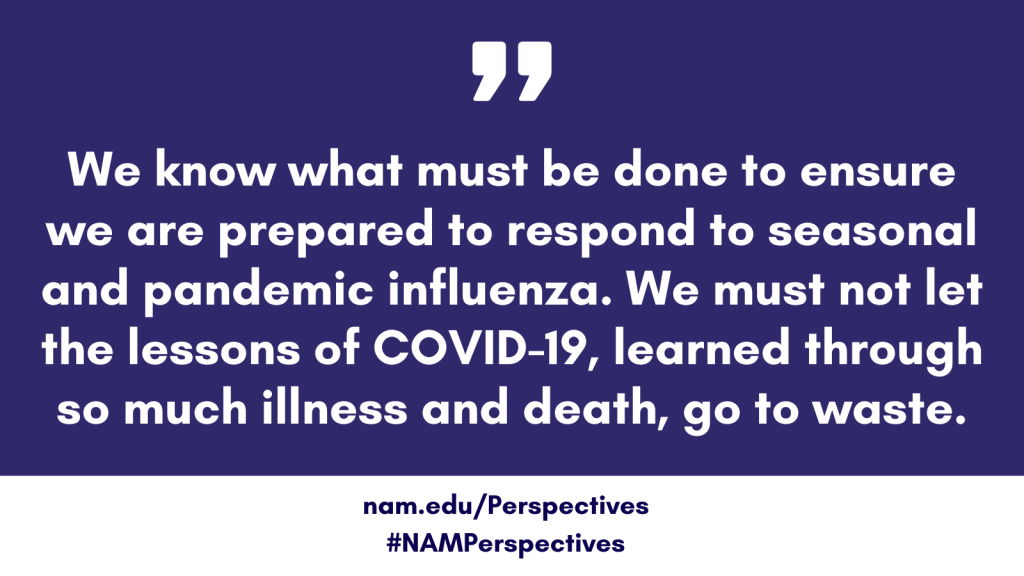
References:
See original publication
Originally published at https://nam.edu on September 19, 2022.












